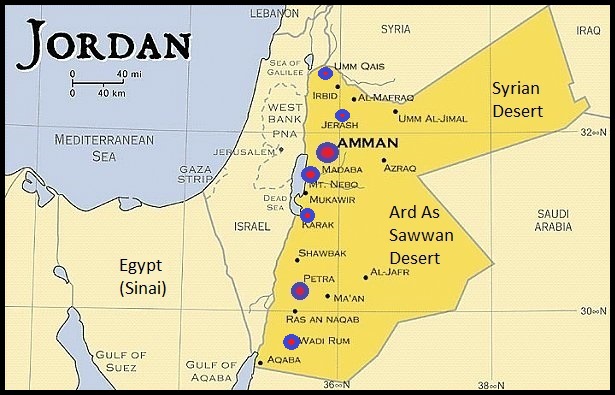|
Continuing History of Jordan:
One of the major populations were the Nabateans, while Jews settled the area of Jordan Valley, within the domain of Roman Judea.
Under the Romans and the Byzantines, Transjordan was home to the Decapolis in the North, with much of the region being designated as Byzantine Arabia.
Classical kingdoms located in the region of Transjordan, such as the Roman-era Nabatean kingdom, which had its capital in Petra, left particularly dramatic ruins popular today with tourists and filmmakers.
With the Great Arab Revolt in 1916 and the consequent British invasion, the area came under Occupied Enemy Territory Administration in 1917 and with the British mandate of Transjordan in early 1920s, it became the Emirate of Transjordan under the Hashemite Emir. In 1946, independent Hashemite Kingdom of Transjordan was formed and shortly admitted to the United Nations and the Arab League.
In 1948, Jordan fought with the newly born state of Israel over lands of former Mandatory Palestine, effectively gaining control of the West Bank and annexing it with its Palestinian population. Jordan lost West Bank in the 1967 War with Israel, and since became the central base of the PLO in its struggle against Israel.
The alliance between the PLO and the Jordanians, active during the War of Attrition, came to an end in the bloody Black September in Jordan in 1970, when a civil war between Jordanians and Palestinians (with Syrian Ba'athist support) took thousands of lives.
In the aftermath, defeated PLO was forced out of Jordan together with tens of thousands of its fighters and their Palestinian families, relocating to South Lebanon.
|
|
|
Return to the
 Home Page Home Page
|
|
 The history of Transjordan continued with the Muslim empires starting in the 7th century, partial crusader control in the mid-Middle Ages (country of Oultrejordain) and finally, Mamluk Sultanate (Cairo) since 13th century and the Ottoman Empire from the 16th century until World War I.
The history of Transjordan continued with the Muslim empires starting in the 7th century, partial crusader control in the mid-Middle Ages (country of Oultrejordain) and finally, Mamluk Sultanate (Cairo) since 13th century and the Ottoman Empire from the 16th century until World War I.